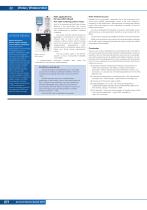 Website:
Swan Analytical Instruments
Website:
Swan Analytical Instruments
Group: SWAN Systeme / Seres OL
Catalog excerpts

Low-Maintenance Turbidimeter for Potable Water Applications Higher demand for safe drinking water and tighter monitoring of contaminants in potable water are in contrast to the current trend towards reducing maintenance / operating costs and remote controlled plants. Main maintenance tasks on a regular base for turbidimeters are cleaning the optical windows and replacement of the light source as well as readjustment / recalibration with a primary standard. A new approach with a non-contact, LED turbidimeter reduces maintenance efforts significantly and thereby contributes to lowering the cost of ownership. State of the art turbidimeters for potable water analysis are based on the nephelometric measurement principle as described in the Standard Methods [1] and adapted by ISO (ISO 7027 [2]) or EPA (EPA 180.1 [3]). A ratio turbidimeter measures the ratio between scattered and transmitted light. If just the transmitted light is detected, it is a single beam turbidimeter. Measuring principle AMI Turbiwell The set up is quite simple but there are some disadvantages, especially in terms of maintenance effort. Several tasks have to be conducted on a regular base for these types of turbidimeters to ensure its reliability and functionality. The main maintenance tasks Nephelometry Cleaning of optical windows In a nephelometric set-up, turbidity is determined by the measurement of light, scattered at an angle of 90° to the incident beam. The turbidimeters consist of a flow cell design, where the optical windows are in direct contact with the sample. It is obvious, that cleaning is sometimes necessary, which means maintenance hours, causing operating costs. Cleaning the optical windows often requires a readjustment of the turbidimeter’s sensitivity. Figure 2: Set-up of the SWAN AMI Turbiwell Readings are from a calibration curve established with a primary standard (i.e. Formazine). Results are expressed in FNU (Formazine Nephelometric Units) or NTU (Nephelometric Turbidity Units). Replacement of the light source A light bulb with a tungsten filament has to be replaced at least once a year which needs a readjustment or recalibration of the turbidimeter. Additionally, a decrease of the lamp intensity leads to wrong measurement values if not monitored correctly The light beam of the LED source falls on the water surface and is refracted. At an angle of 90°, the detector measures the incoming, scattered light. The transmitted beam intensity is not measured; therefore, the AMI Turbiwell is a single beam turbidimeter and not a ratio turbidimeter. The special design of the chamber (barrier and beam trap) prevents measurement errors due to light reflection. A dark current measurement is completed at least once a day to compensate the influence of temperature variations on the electronics But how can a single beam turbidimeter compensate for fluctuations in the intensity of the light source? “Normalisation” of Turbidity Signals Chamber drain Figure 1: Schematic set-up of a nephelometric turbidimeter Settled particles in the measurement chamber have to be removed from time to time to avoid interference based on a carry-over effect. Normalised turbidity signal Scattered light intensity Emitting light intensity The new SWAN AMI Turbiwell In the design of the new AMI Turbiwell, the focus was on low maintenance: Hgh precision Secondary Standard for AMI Turbiwell • Non-contact set-up: The optical windows are not in direct contact with the sample which means there is no fouling and as a consequence, no cleaning is required. The optical windows are heated to prevent condensation. • Light source: Instead of a “light bulb” with a lifetime of around 8000 operating hours, a light emitting diode (LED) with a lifetime of approximately 100’000 operating hours is used. Therefore, a replacement is not necessary and readjustment or recalibration is redundant. Two different light sources are available which are either ISO 7027 compliant or accepted as an alternative method to EPA 180.1 [4]/[5] • Chamber drain: An automatic or manual chamber drain avoids a carry-over effect and contributes to reliable measurement value. The absence of the transmitted beam intensity measurement and consequently the absence of the ratio for light source fluctuation compensation requires a new/different approach. Compensation is achieved by normalizing the emitted light intensity. A beam splitter (semi-transparent mirror) within the light source directs a part of the emitted light to a photodiode which registers the emitted beam intensity. Building the ratio of the scattered light intensity to the emitted beam intensity eliminates the fluctuations in the light source. This “normalisation”, the non-contact set-up, the long-life LED light source and the regular chamber drain make a recalibration of the turbidimeter with a primary standard unnecessary. If a system check is required due to local regulations, a dry verification using a high precision secondary standard can be conducted to validate the instrument’s performance.
Open the catalog to page 1
AUTHOR DETAILS Markus Bernasconi Sales & Support manager Swan Analytical Instruments Markus Bernasconi, graduated from the University of Applied Sciences in Burgdorf, Switzerland in 2000 with a bachelor degree in chemistry and in 2002 with a post graduate course in integrated micro systems. He worked at the same location for about 4 years, leading research projects in the field of thin film deposition (PVD, CVD) and wet chemical wafer processing. He then changed to Mettler-Toledo Thornton, working as a project leader in the R&D. Subsequently, he joined Swan Analytical Instruments in 2006...
Open the catalog to page 2All Swan Analytical Instruments catalogs and technical brochures
-
AMI ISE Universal
2 Pages
-
AMI Hydrazine
2 Pages
-
AMI Codes-II TC
2 Pages
-
AMI Codes-II
2 Pages
-
AMI CACE
2 Pages
-
AMI pH/Redox
2 Pages
-
An Introduction for Non-Chemists
19 Pages
-
Pautbac II
2 Pages
-
Opal
2 Pages
-
TOC Evolution VUV
2 Pages
-
Topaz Analyzer
2 Pages
-
Automated Quality Assurance
6 Pages
-
Seven Sins of Steam Sampling
16 Pages






















